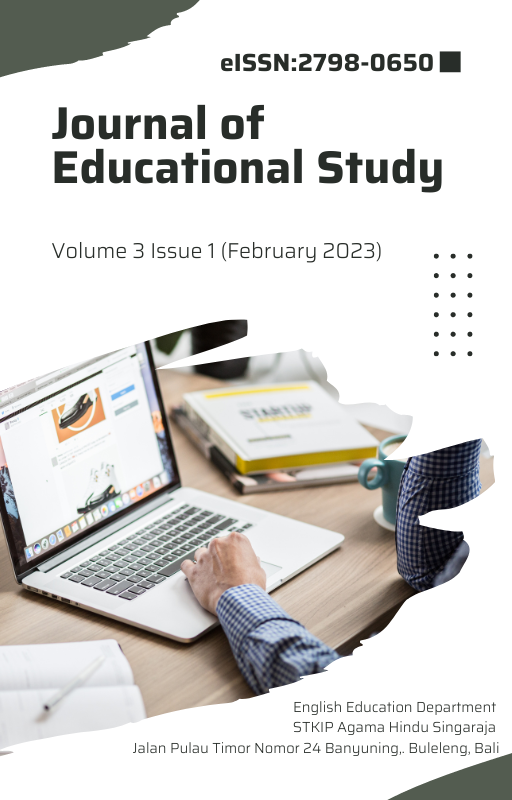Students’ Effort for Independent Learning Through Voluntary Extensive Reading
DOI:
https://doi.org/10.36663/joes.v3i1.379Keywords:
Extensive Reading, Reading Motives, Reading MaterialsAbstract
This study was aimed at analyzing students’ effort for independent learning through voluntary extensive reading in which it was viewed from students’ reading motives and materials. This study was designed in the form of qualitative study by involving 30 junior high school students and the data were gained through observation, interview, and survey. The instruments were the researcher, observation sheet, interview guide, and questionnaire. The collected data were analyzed by using qualitative data analysis. The findings revealed that; 1) the English reading materials read by the students are the materials related to the school materials, fiction (story, novel), and news, 2) students have their motives in reading extensively, namely to gain experience and skills in English language, to learn new things, to be confident and to improve ability in using the language. This study suggested that teachers to encourage extensive reading in classroom.
Downloads
References
Aida, S. N., & Widiyati, E. (2020). Extensive reading to improve students’ writing of explanation text. EduLite: Journal of English Education, Literature and Culture, 5(1), 109. https://doi.org/10.30659/e.5.1.109-117
Almendo, T. (2020). Challenging Efl Students To Read : Digital Reader Response Tasks To Foster Learner. Teaching English with Technology, 20(2), 21–41.
Anindita, C. (2020). EFL students’ perception towards extensive reading practice in higher education level. RETAIN, 08(4), 89–98.
Ary, D., Jacobs, L. C., Sorensen, C., & Razavieh, A. (2006). Introduction to Research in Education.
Badriyah, B., & Rahmawati, E. (2020). Students’ Problems of Reading Comprehension During Online Learning in the Period of Covid-19 Pandemic. Proceedings of the 2nd International Conference on English Language Education (ICONELE) 2020, 286–298.
Bui, T. N., & Macalister, J. (2021). Extensive reading in an EFL classroom: Impact and learners’ perceptions. Reading in a Foreign Language, 33(1), 109–131. https://doi.org/10.32601/ejal.911195
Celik, B. (2019). The Role of Extensive Reading in Fostering the Development of Grammar and Vocabulary Knowledge. International Journal of Social Sciences & Educational Studies, 6(1), 215–223. https://doi.org/10.23918/ijsses.v6i1p215
Chostelidou, D. (2011). Needs-based course design: The impact of general English knowledge on the effectiveness of an ESP teaching intervention. Procedia - Social and Behavioral Sciences, 15, 403–409. https://doi.org/10.1016/j.sbspro.2011.03.112
Day, R. (2015). Extending Extensive Reading. Reading in a Foreign Language, 27(2), 294–301.
Do, D. T. T. (2017). News Report: A Blended Extensive Reading and Intensive Reading Activity. Journal of Development Research, 1(2), 55. https://doi.org/10.28926/jdr.v1i2.23
Edwards, N. (2000). Language for business: Effective needs assessment, syllabus design and materials preparation in a practical ESP case study. English for Specific Purposes, 19(3), 291–296. https://doi.org/10.1016/S0889-4906(98)00029-5
Fatimah, A. S., Kardijan, D., & Sulastri, F. (2020). Blogging in Extensive Reading: Students’ Voice in Blended Learning Classroom. Vision: Journal for Language and Foreign Language Learning, 9(1), 81. https://doi.org/10.21580/vjv9i14847
Hariyanto, I. P. D. (2019). The Implementation of Extensive Reading and the Contribution to Students ’ Independent Learning . LangEdu Journal, 3(1).
Jacobs, G. M. (2014). Selecting Extensive Reading Materials. Beyond Words, 2(1), 112–127.
Khusniyah, N. L. (2021). English Extensive Reading Material Needs in Digital Era. AL-ISHLAH: Jurnal Pendidikan, 13(1), 763–768. https://doi.org/10.35445/alishlah.v13i1.560
Mardiana, E., & Hidayat, N. (2019). The Effect of Extensive Reading on Students’ Reading Achievement Of Senior High School. Kontribusia, 2(2), 16. https://doi.org/10.30587/kontribusia.v2i2.1004
Meinawati, E., Purwaningrum, P. W., & Setianingrum, H. W. (2021). The Online English Extensive Reading Activities Using Google Classroom in Pandemic Covid-19. Eralingua: Jurnal Pendidikan Bahasa Asing Dan Sastra, 5(2), 459–469.
Mermelstein, A. D. (2014). Improving EFL Learners’ Reading Levels through Extensive Reading. Reading Matrix: An International Online Journal, 14(2), 227–242.
Miles, M. B., & Huberman, A. M. (1994). Qualitative Data Analysis (Second Edi). Sage Publication.
Muchtar, N. (2019). Intensive and Extensive Reading in Improving Teaching Reading Comprehension. Lingua Pedagogia; Journal of English Teaching Studies, 1(2), 1–13.
Puspitasari, E. (2019). “I Love Creepy Pasta”: EFL Students’ Book Selection for Extensive Reading. 353(IcoSIHESS), 50–55. https://doi.org/10.2991/icosihess-19.2019.8
Rahadhiyanti, D. A., Tasnim, Z., & Sundari, S. (2016). Using Authentic Reading Materials from Internet to enhance the Eighth Grade Students ` Reading Comprehension. EFL Education Journal, 3(8), 573–584.
Singkum, R., & Chinwonno, A. (2021). Implementing efl extensive reading for thai vocational students. LEARN Journal: Language Education and Acquisition Research Network, 14(1), 208–239.
Syamsuddin, M. R. (2021). The Role of Extensive Reading in Improving General English Proficiency. P-JEIS: Parahikma Journal of Education and Integrated Sciences, 25–32.
Takase, A. (2009). The effects of different types of extensive reading materials on reading amount, attitude and motivation. In Extensive reading in English language teaching (pp. 451–466). Munich.
Waring, R. (2019). Extensive reading in English language teaching Extensive Reading in English Teaching. November.
Yunus, M., & Ubaidillah, M. F. (2021). EFL teacher educators’ experiences in teaching critical reading: evidence from Indonesia. Journal on English as a Foreign Language, 11(2), 422–441. https://doi.org/10.23971/jefl.v11i2.3133
Downloads
Published
How to Cite
Issue
Section
License
Copyright (c) 2022 I Gede Made Artha Nugraha, Luh Putu Artini, Ida Ayu Made Istri Utami

This work is licensed under a Creative Commons Attribution 4.0 International License.
https://creativecommons.org/licenses/by-sa/4.0/















